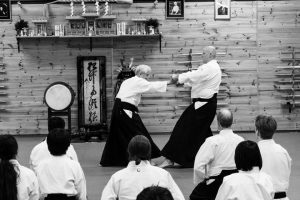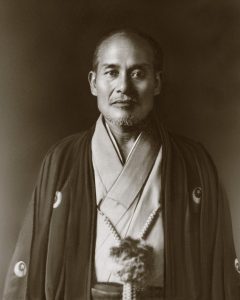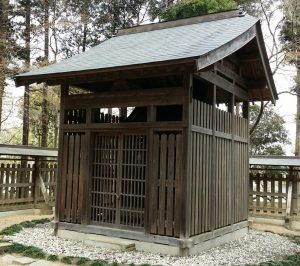 I wonder sometimes where the art of Aikido veered of the path the founder set for it.
I wonder sometimes where the art of Aikido veered of the path the founder set for it.
Truth is traditional Japanese arts cannot be studied in a western way, they weren’t designed to be, and were never intended to be.
Knowledge and wisdom come from two different places.
My focus in teaching this year is ukemi.
Below are many quotes from students of the founder. Read them to understand what he meant, and how learning in Aikido was supposed to be transmitted.
The art of Ukemi, true ukemi (this is not rolling, falling down, break falling or “performing”) is the path to understanding the hidden. It is linked to tanren(forging or tempering the body) and misogi harai (purification of the spirit).
There are not two ways, his game means his rules………… Enjoy!
^^^^^^
The “Riai” (principle/truth) (this is what is “hidden” (Ura) not what is taught) must be the base which gives coherence and reason to all things.
If we were to analyze or breakdown the Riai like a scientist might, we can call the things that we find manifested on the physical surface (omote) “Ho”, [that is to say a rule or method or law].
Aikido is one such Ho. It is one of the subtle laws of the heaven-sent truth of Takemusu Aiki (literally Bu generating Aiki).
We can also call it the “Way of Accord between Heaven, Earth and Man,” and therefore it can be described as the Way of reconciling the myriad essences and their multiple manifestations.
You must know that Aikido techniques are a Way of Misogi, [that is, of ritual purification] of the body and the spirit/mind (kokoro) and a way of training.
That fact is what makes us aware of the laws of the universe (ie, training as misogi Harai to purify body is what makes us understand universal principle, not thinking or chatting or intellectualising, but training) – and that same fact is the core truth of the workings of the Universal.
For these reasons once you have mastered this Aikido you will understand the Universal Rational and also come to a good understanding of your own self.
For example, if you move a sword you put into that action your entire self and unite with the whole universe for that movement.
In Aikido there is a subtle and mysteriously clever way of swordsmanship.
In this Way of the Sword, if you can not completely perfect the fundamental morality your art will surely become that of the
“Perverted Sword of Injustice and Wickedness”.
But just what is this. fundamental morality of humanity?
It is keeping to the virtues of fidelity, honesty and exemplary behavior, charity of heart and faithfulness. It is to make truth, joy, and beauty the foundation by which you protect and preserve them. Then by making one’s very best effort, to bring forth virtue.
We must strive in the direction of becoming more and more wise and sharp of sensitivity. It is necessary to have an absolute and all encompassing sincerity in all things. In short we have to proceed toward the “Way of Accord” in the spirit of Love congealed of Love.
In order to attain this sincere mind and foster it, we must start by over-coming ourselves!
Morihei Ueshiba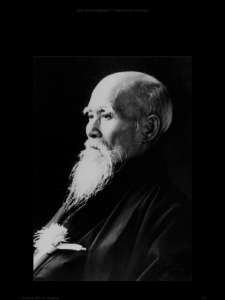
The Nelson kanji dictionary defines the two kanji that make up the word “rial” as meaning “reason,” or “ri-“ (principle, truth) with “coming together, meeting, or harmonizing (“-ai”). In other words, in budo, riai is the underlying principles behind a technique, it is in essence a realisation, of the “truth” hidden inside the form.
Henry Kono –
He never explained what he did, he just did it! This is what I mean by magician. He did it and if you couldn’t discern what he did, there was no way to figure it out. He never explained anything but he left hints which were very difficult to discern because of the way he stated his ideas in very short phrases that no one could understand.
I saw a tape of Shioda Sensei being interviewed in England. He was with O-Sensei for ten years from about 1930-40, he said O-Sensei never explained once in that 10 years as to what he was doing!
He wasn’t a teacher in the sense that he was teaching. The Japanese may look at that as teaching, but in the western sense it isn’t. You had to intuit what he was doing and saying, read between the lines, so to speak.
Henry Kono: O Sensei did not hide anything, everything was unveiled right in front of us but we could not see it. In fact, it has always been the norm for great masters of martial arts to take their knowledge with them to the grave. Ueshiba was no different. Alan Ruddock has a video of Gozo Shioda Sensei where he says that never, during the 10 years that he spent with O Sensei, the master explained what he was doing, not a single time. Shioda had to interpret everything by himself.
We were trying our best to reproduce what we saw him doing but with very little success. Besides, it is one thing that we could not reproduce what he showed but he, himself, constantly refused to explain us what we were not getting. If you did not get it, he would simply do the technique again and say “look carefully!” but never would he give any explanation. As surprising as it sounds, this was actually very typical of O Sensei’s way of teaching and to a larger extent, it was common to all the great Japanese masters of Budo. These men always took their secrets with them to the grave and O Sensei was no different.
I remember an interview of Gozo Shioda Sensei that he gave in England a few years ago where he explained that during the 10 years he stayed with O Sensei; never did he receive any explanation from the master about what he was doing. Therefore, Shioda had to patiently interpret everything by himself without any other form of instruction than watching his master demonstrate.
Henry Kono: Yes, I have seen videos where some Sensei say this. But it is precisely on this point that they missed the essential. Actually, Ueshiba Sensei only removed the notions of victory and defeat from his Budo. I think that he had been really shocked by what had happened during the Second World War, in particular with the two atomic bombs. He realized that if men were to carry on opposing each other, competing and making war, it would soon be the end. Therefore, he started from what he knew; Daito-Ryu Aiki-jujutsu, and used it to develop a system of harmonious resolution of conflicts. He could have used a completely different approach though. Despite this, the martiality and the efficacy were still very present, but freed from the visible aspect of opposition. It is obvious when you compare pre- and post-war videos. O Sensei often said “forget what I used to do before, this time is over. Now, I do Aikido!”
Rinjiro Shirata –
Beginners learned techniques from the uchideshi, starting with the ikkajo of Daito-ryu
Jujutsu. Techniques like ikkajo, nikajo, shihonage… There wasn’t any iriminage then, only techniques which, on later reflection, can be considered to be the antecedents of iriminage. Iriminage was originally developed by O-Sensei. Sensei’s techniques were always changing. Techniques which had their origin in Daito-ryu were transformed into aiki, and as he trained himself, gradually his techniques changed as well. That’s why the techniques Tomiki Sensei learned, the techniques we learned, the techniques Shioda Sensei learned, and the techniques Murashige Sensei learned before that, were all completely different.
Sensei sometimes said to me, “Shirata, my techniques have changed. Look!” So I watched him. They became circular in a way completely different from his earlier techniques.
Even though Ueshiba Sensei studied Daito-ryu, it does not mean that his art was Daito-ryu. O-Sensei went beyond that, and combined various budo
and created what we call “Aiki no Jutsu.”
Although some of the original Daito-ryu forms remained in his art, his way of thinking and way of moving the body were very different.
My aikido and Ueshiba Sensei’s aikido are quite different. The techniques of Tomiki Sensei, Shioda Sensei, and Saito Sensei are all different. There is nothing wrong with this. Since aikido is formless, we move according to how we feel. However, we must do this without forgetting the spirit of budo in ourselves.
We must practice, but not let our techniques turn into an aiki dance. It may be okay if we “dance” at the beginning, but gradually, it has to become an expression of budo. Ueshiba Sensei expressed aikido in a budo way. Religious people express aiki in religious terms. Aiki is expressed by singers in songs, and artists in their art. Aiki pervades everything. We merely express things which unite us with the universe.
I think this is as it should be.
There are many poems concerning the kotodama. The “Way of the Mountain Echo”
[yamabiko] is kotodama, and of course it also refers to aikido. If you say, “Ya-ho” [a mountain call used to produce an echo] and you hear “ya-ho” echoing back, this is called yamabiko.
This is kotodama. There are a great many poems entitled “Yamabiko no Michi” which refer to the fact that your mind and your partner’s mind are in mutual communication. I am proposing to Doshu that he proceed one step further in conjunction with the one hundredth anniversary of the Founder’s birth, and write about his state of mind. Otherwise, the essence of aikido cannot be understood. When we demonstrate techniques in the dojo, we should explain that this is kotodama. We have to show ki in realistic terms. We have to show that this is not a budo of competition.
Kotodama is not sounds.
It is the echo of ki which precedes the emergence of sounds.
Sounds are the next stage.
Kotodama comes first, and preceding it, there is ki.
Ki changes into many forms. It becomes sound, light, and kokyu. When two sources of ki combine, this results in kokyu. While breathing, it becomes sound, light, kotodama, and many other things.
Then it becomes hibiki [echoes], that is, the seventy-five sounds. Subtle changes of hibiki become the mystery of creation. First, there was the word and the word was God—this is kotodama and also aiki.
I think young people had better train hard while they are young, especially those who
intend to become instructors. Then they can become soft gradually. Being soft from the beginning is also worthwhile because, if you cause young people to train hard, some may give up aikido. In this respect, soft training has some merit.
However, those who want to become instructors cannot reach that level unless they train hard.
This type of training should include the mind. Unless the training is severe, you can’t reach that level. The reason Ueshiba Sensei reached that level was due not only to his natural talent, but also to the fact that he engaged in severe training.
Although material civilization and science have improved, people still struggle all the
time. When we reach the final stage, when fighting is considered evil, a different, aikido-like world will be born. Neither Christ nor Buddha taught this. As times change, various great wise men, whom we call messengers, are sent in turn to reform mankind. I think that this is a truly wonderful love. Although the wicked sons of the earth are absorbed in killing one another, heavenly messengers continue to come to the earth to lend a helping hand. I think this shows the true love of the kami. The purpose of the birth of people in this world is to realize the love of the kami in this world.
Ueshiba Sensei said clearly that human beings are “the children of the kami, the living shrine of the kami. Human beings by nature occupy a small space.” Everything is contained in these words. It is written simply and concisely in the Dobun. If you have trained sufficiently, you will understand it as soon as you read it. If you read only the words, you will be confused. We read them repeatedly, and gradually we understand what it was he said.
Gozo Shioda –
Today’s aikido is dimensionless. It’s empty of content. Now we see nothing but imitation, without any grasp of the real thing. People try to reach the highest levels without even paying their dues. That’s why it seems so much like a dance these days. Ueshiba Sensei was the only one who could do that sort of soft, fluffy movement. You have to master the basics solidly, with your body, and then proceed to develop to the higher levels.
We old-timers received our training from Sensei during the time his youth was still
in full bloom. But only O-Sensei was able to perform techniques without resorting to
power. Even if you are told not to use power, you still can’t do it. At one stage, you put
in every bit of your power and exert yourself in training. That gradually over time will
develop into aiki.
Zenzaburo Akizawa –
A big demonstration is held every year at the Budokan [in central Tokyo], but it’s really not much more than a pre-arranged display. Don’t you think that if things continue in this direction, aikido will become just some kind of dance?
There’s nothing wrong with a dojo being considered a place for healthy exercise, but from the point of view of budo, it seems that a little something is lacking.
O-Sensei was an astonishing person, that’s for sure! However, without doing some sort of spiritual training, no one can ever hope to become like him. People who are training today may well be folding their hands before the kamisama, but few are practicing Zen meditation.
Therefore, they cannot hope to become divinely inspired as O-Sensei did. That’s why we make progress to a certain point, but then find ourselves running into a wall.
I suppose it isn’t fair to compare, but I really am worried about whether or not people
nowadays have an acceptable level of strength. O-Sensei died, and gradually the people who were uchideshi are also passing from the scene. Those qualified to teach are becoming fewer and fewer. Of course, there are some wonderful teachers now, too. People like Saito, Shioda, and Shirata are really strong.
Koichi Tohei –
This occult-style ki just isn’t possible. That which does not exist simply does not
exist, and that’s the end of it! Knocking someone over by glaring at them, for example.
It’s so obvious that that sort of thing is fraudulent. It’s just not possible! There are
some who would say that nobody knows aikido better than I do, right? So if I focus a
concentrated glare on you, are you going to fall over? I doubt it!
Many people were surprised that I was able to throw the sumo wrestler Kurosegawa,
seemingly without touching him. People think, “Tohei can throw people without
touching them!” But that’s not right. I may not have been touching him with my hands,
but I was touching him with my ki. A person that comes rushing forward to attack is
preceded by his ki, and wherever that ki goes, his body is obliged to follow. (This is
why it is impossible to throw people who are not really intending to attack you.) So all
I had to do was evade his ki; I simply let him go where he seemed to want to go, and
he fell of his own accord.
Ki is something that is conveyed from one person to another. If you like someone
a lot, that person is bound to pick up on your feeling. The only reason it is possible for
me to throw a very large individual who is moving in with a strike or other attack is that
I am able to grasp his mind, his intention, the instant it manifests itself.
This is one of the things that Ueshiba Sensei truly wanted to teach. Much of the
aikido we see today has degenerated into mere fighting. I call what I do Shin Shin
Toitsu Aikido, because I don’t want to be associated with that kind of aikido. Aikido
is a path to harmony with the universe, and it should suffice to call it aikido (since the
name incorporates this meaning), but for the sake of clarity, I added Shin Shin Toitsu.
Abroad it is referred to as “Ki Aikido.”
Kanshu Sunadomari –
I seize my partner at the exact moment he grabs. That’s the point I’ve reached. In terms of body movement, it is enough to avoid the opponent’s strike. It is not necessary to move the attacking hand. When my partner grabs, he himself ends up being grabbed. When my partner touches me, I move to the inside faster than him. Your own feeling must flow at this point. Your power will pour forth just at the time you extend your ki naturally. The power has already gone there when you extend your ki to encourage his attack.
I leave everything to this power. We become as one body when I suddenly stop the flow of my power and have completely entered to the inside of my partner.
However, it is not merely a matter of the two of us being close together, but rather,
I become the center, and after I have moved in close to him, I can cause my partner to move freely.
Ueshiba Sensei often said, “It is a matter of who is the faster.” I used to think
superficially of speed, which involved collisions when I was still immature.
But I understood that it was not at all the case when I discovered kokyu power. As soon as he grabs me, I enter to his inside. I become the center and become as one with my partner, and am completely bound up with him.
When this happens, techniques freely emerge.
You must not act using unnecessary power. You rely on the point of contact with your partner.
If you do this, other kinds of power are naturally eliminated. It is a matter of feeling. It is not a matter of the mechanics of the technique.
Ueshiba Sensei clearly said to me before I came to Kumamoto, “There are no head
families (soke) in budo.” The fact that there are no head families in budo means that
aikido technique is limitless, and those who truly master the Way can transmit it. I think that one will not be able to comprehend Ueshiba’s Sensei true mind without practicing aikido with a clear understanding of this.
One’s aikido remains frozen.
By transmitting only unchanged form, you are led in a direction which is contrary to Sensei’s thought.
Your techniques become one if you study the spiritual aspect of Morihei Ueshiba Sensei.
You have to continually overcome barriers. Aiki is a matter of you becoming one with
others.
You have to create techniques which unite you and your opponent.
If you are not able to achieve this, you should not use the expression “Aiki is love,” in an ideologically sense.
This is something you can achieve through your body, and you should not think
that spiritual matters are separate.
I don’t think there should be various kinds of aikido. The goal of aikido is the study of
the spirit of Morihei Ueshiba Sensei.
The true world of harmony will be created through aikido, after the barriers have been overcome, when all human beings come to a realization of how wonderful aikido is. I think that this was the mission of Morihei Ueshiba Sensei.
It was difficult for O-Sensei to cause the flower of aikido to bloom and bear fruit. However, if Sensei hadn’t created the seeds, the Way of aikido would not have been transmitted. We students should assimilate the seeds, grasp the goal, so to speak, and decide what flowers should be made to bloom, what fruit should be allowed to ripen. If you wish to pursue the path of injuring and beating your opponent, something other than aikido will be best. There are many other arts for this purpose. Unless this is truly understood by practitioners of aikido, the art may end up being unfavorably criticized.
Michio Hikitsuchi
After the war the founders thinking about Budo had changed radically. And the way he related to people also changed. His fierce gaze had become more tender. One felt more like getting closer to him. It was as you see in photos taken in his old age. His eyes were still strict, but they were no longer so scary.
After the war, O-Sensei’s thinking about waza also changed enormously. Before the war, the purpose of waza had been to kill the attacker. And we had practiced like that. After the war, he urged us not to attack opponents or to think of beating them up. “If you do that,” he said, “it will be the same as before. I have changed how we do everything.”
O-Sensei told us that we must give our opponents joy. To do this, he said, we must become capable of immediately sensing their ki. And, to do this, we must unify ourselves, we must unify our words, our body, and our mind. We must become one with the workings of all things in the universe — with Kami and the forces of Nature. We must bring all three things — words, body, and mind — into harmony with the workings of the universe. “If you do that,” O-Sensei said, “true Budo will be born. The Budo of destroying others will become transformed into the Budo of offering joy and compassion to others.”
After the war the method of practice was the opposite of what it had been. We no longer attacked. We looked at our partners’ ki in order to see the whole of them. From the top of their head to the tips of their toes. Not just external appearances. We needed to become able to absorb our partners’ minds.
Training this way was more difficult. We couldn’t wait for a partner to attack. We had to have the ability to instantly perceive the partner’s suki (openings) and intent to attack.Where will they strike? How will they move? We had to train to cultivate these sensing abilities in ourselves.
Now all the techniques I teach are those of the postwar period. They are the true waza of O-Sensei’s Aikido.
If we look at our partners, our hearts will be taken by them. Never look in their eyes. If we look in our partners’ eyes, our minds will be snatched away by their eyes. If we look at our opponent’s weapon, our ki will be stolen by that weapon. So, we must not stare at our partners.
If we are always one with the universe, one with great nature, there is no space for the opponent to attack.
When opponents do try to attack, we must not rely on form alone, but spontaneously create technique.
In the old days, when the opponent attacked, we parried the blow and drove forward. After the war, things changed. The instant the opponent raised his arm to strike, even as he was raising his arm, we were already changing position. We had to act quickly. To do it well, we had to become one with nature and move without thinking.
Another aspect of postwar Aikido was O-Sensei’s even greater emphasis on shinji for spiritual purification at the beginning of every practice session. He’d always begin with purification.
And below, the secret to understanding riai…………
So for your first three years in aikido you were only uke?
Henry Kono – That was the concept. I used to ask, “I have been doing this for a year and I don’t know what the hell I’m doing.” They said, “Don’t worry Kono-san. Just take uke! It will come clear to you.” It was important to develop this body sensitivity and mobility.
Sensitivity is important…
Because I’m learning exactly what you are doing. You are really becoming yin. You have to be soft. Then the center starts to develop. That’s the only way to develop it.
****************************************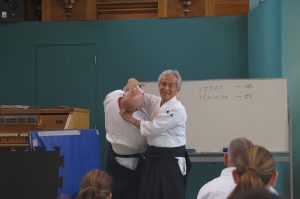
“DONT RESIST, RECEIVE UKEMI”
Maruyama Sensei
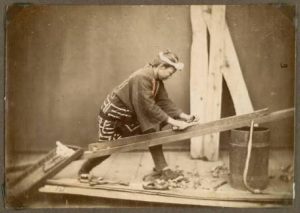 The following passage is from a lecture given by Yamaoka Tesshu to his students. In it he tries to explain the process of Shugyo.
The following passage is from a lecture given by Yamaoka Tesshu to his students. In it he tries to explain the process of Shugyo.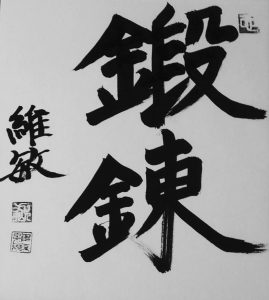
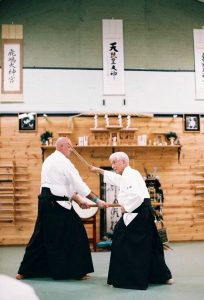

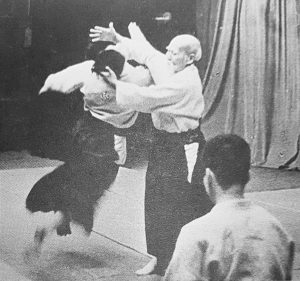 A movement away from the view of harmony that is technical in nature represented by ki ichi hogan secrets of technique towards a greater understanding that true harmony comes from nothingness, this is any number multiplied by zero being zero.
A movement away from the view of harmony that is technical in nature represented by ki ichi hogan secrets of technique towards a greater understanding that true harmony comes from nothingness, this is any number multiplied by zero being zero.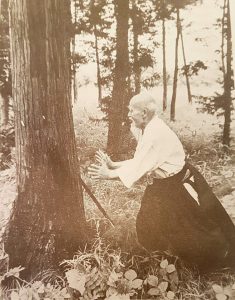 Training in, aikido is training to build an “Aiki body” (founders words, not mine).
Training in, aikido is training to build an “Aiki body” (founders words, not mine). Relax completely – not possible without understanding the previous two. This relaxation is not a “polite” type of relaxation, but one that permeates the entire fabric, when one is connected, the attackers feels the ground through the frame, not the frame. It is not enough to think you are relaxed, you have to know/experience this feeling. Within this feeling, and only within this feeling can we become “invisible” to the attacker. You cannot resist what you cannot feel.
Relax completely – not possible without understanding the previous two. This relaxation is not a “polite” type of relaxation, but one that permeates the entire fabric, when one is connected, the attackers feels the ground through the frame, not the frame. It is not enough to think you are relaxed, you have to know/experience this feeling. Within this feeling, and only within this feeling can we become “invisible” to the attacker. You cannot resist what you cannot feel.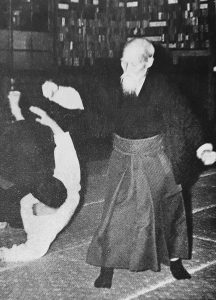 “We must practice, but not let our techniques turn into an aiki dance. It may be okay if we “dance” at the beginning, but gradually, it has to become an expression of budo. Ueshiba Sensei expressed aikido in a budo way. Religious people express aiki in religious terms. Aiki is expressed by singers in songs, and artists in their art. Aiki pervades everything. We merely express things which unite us with the universe.
“We must practice, but not let our techniques turn into an aiki dance. It may be okay if we “dance” at the beginning, but gradually, it has to become an expression of budo. Ueshiba Sensei expressed aikido in a budo way. Religious people express aiki in religious terms. Aiki is expressed by singers in songs, and artists in their art. Aiki pervades everything. We merely express things which unite us with the universe.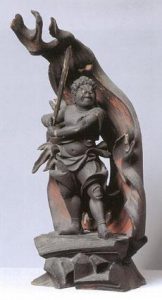
 I wonder sometimes where the art of Aikido veered of the path the founder set for it.
I wonder sometimes where the art of Aikido veered of the path the founder set for it.
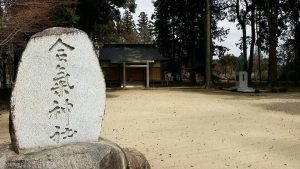 There has been a big push recently on social media in Aikido circles, with many experts (some are, many are not) in the field asked to comment on various topics.
There has been a big push recently on social media in Aikido circles, with many experts (some are, many are not) in the field asked to comment on various topics.